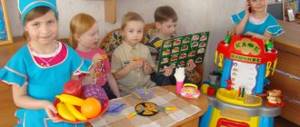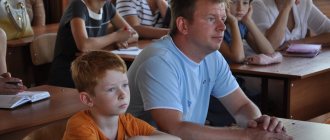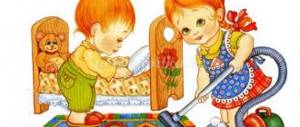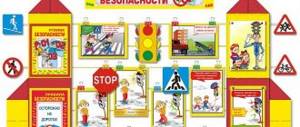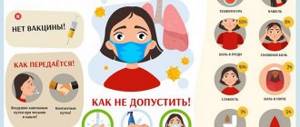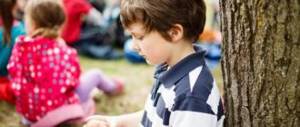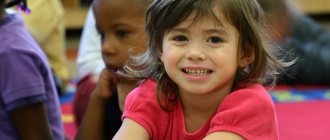Consultations for parents in kindergarten. Artistic and aesthetic education of children
Artistic and aesthetic education of children in the family
Aesthetic feelings and sensitivity to beauty not only enrich a child’s life, his spiritual world, but also influence his behavior and actions.
Therefore, the education of aesthetic sensitivity in the comprehensive development of a child’s personality is of such great importance. Consequently, the task of the family is to develop the child’s aesthetic sensitivity to everything around him. Even the smallest child has elementary aesthetic feelings. He reaches out to a colorful, elegant toy, he feels pleasure while listening to a funny song. Very often we hear enthusiastic exclamations from children: “Look, what a beautiful flower!”, “Look, what a butterfly!” But, unfortunately, we do not always pay attention to this. Like all abilities, the capacity for aesthetic sensitivity can be developed. A child who likes a flower or a butterfly will try to treat it with care. Already on the basis of this primary aesthetic sensitivity, the child develops aesthetic feelings and attitudes, which are a necessary prerequisite for the formation of an active humanistic attitude towards the world around him. How should one cultivate the ability for aesthetic sensitivity in a child in the family? Of great importance here is the cultivation of his powers of observation, the ability to see and examine. Observation enriches the child’s knowledge and visual representations of objects. Both sides, cognitive and emotional, are closely interconnected in a child. Consequently, this is the most important aspect of educational work in the family. Parents need to remember that any excursion with children into nature, walks around the city, or to the park are of great importance for the child. It is necessary to draw children's attention to the features and beauty of individual buildings in the city, to their differences, to the brightness and colorfulness of this or that design. Admire the beauty of flowering trees, bushes, flowers. Notice the changes that occur in nature: the color of leaves changes depending on the time of year, migratory birds fly south and then return again, clouds and clouds in the sky have different colors and shapes. The ability to contemplate beauty and enjoy it is very important for the development of children's creativity. There will always be objects for observation in order to expand a child’s ideas about the world, its variability and beauty: these are birds flying over a meadow, a fluffy bumblebee sitting on a flower, snowflakes smoothly falling to the ground, and fallen leaves blown by the wind. This is also of great importance in awakening and strengthening the child’s love for his native nature, for his city, for his country. A child’s aesthetic sensitivity should be developed by drawing his attention to small everyday phenomena and everyday objects that are familiar to him. This obliges parents to carefully select things and objects that the child uses in everyday life. Drawing classes provide great opportunities for the development of artistic and aesthetic sensitivity. The approach to depicting the child’s activities in the family is very important here. You cannot exaggerate a child’s artistic abilities, and even more so you should not treat his creativity carelessly as pampering. When drawing, a child not only depicts certain objects or phenomena, but also expresses, by all possible means, his attitude towards what is depicted.
Therefore, the process of drawing in a child is associated with an assessment of his activity. And here the child’s feelings, including aesthetic ones, play a big role. Here parents need to help little artists. And the most important thing is to notice the child’s craving for creativity in time and support him. Nurturing a child’s lively aesthetic sensitivity to the environment and the necessary assistance in his visual activities, all kinds of encouragement and thoughtful organization of the child’s communication with art - all this is available to the family. And this will be a solid foundation for the further aesthetic development of the child’s personality.
We recommend watching:
Consultation for parents of preschool educational institutions Games for the development of fine motor skills in preschool children Consultation for parents of kindergarten Recommendation for parents of future first-graders
Similar articles:
Consultation for parents of kindergarten “Going to the store with a child”
Consultation for parents. Traveling with a child in summer
Consultation for parents “Bicycle and child”
Types of family education and their characteristics
The influence of parents on the formation of a child's personality
The role of the family in artistic and aesthetic education
No matter how important the kindergarten and all kinds of clubs and studios play in a child’s life, the most significant role in shaping his artistic taste and idea of beauty will be played by his family. It is the parents and their contribution to the child’s upbringing that will play a decisive role in the development of his personality in the future.
Only parents can help their child start music lessons
What should you pay attention to first and what forms of organizing and conducting aesthetic education for preschoolers will be more effective?
Personal example. Who is the first moral and aesthetic ideal in the life of any person? Of course, his parents. It is their behavior and habits that the child will unconsciously copy in the first years of life, and it is they who will subsequently develop into established and strengthened forms of behavior. Therefore, any parent who wants to raise a well-mannered and cultured child should be primarily interested in self-development and self-education.
The manners of behavior accepted in the family, the forms of interaction with others, the criteria by which the beautiful is separated from the ugly, the acceptable from the unacceptable - all this will subsequently be adopted by the child. And on these foundations his worldview, view of the world, etc. will be built.
A children's book is one of the means of aesthetic education.
Proper aesthetic education of preschool children in the family and its methods are built on many basic components of its organization:
- A culture of appearance is expressed by observing body culture, the rules of basic hygiene, the ability to choose an outfit in accordance with the requirements of the environment, and the ability to create an overall aesthetically consistent composition of clothing and accessories.
- Culture of emotions; the ability to sincerely show one’s condition without crossing the boundaries of what is permitted.
- Reasonable discipline; the presence of mandatory regulations.
- General artistic taste. The child should be able to see around him works of art used to decorate everyday life: these could be paintings, works of decorative and applied art, etc.
- Aesthetics of everyday life. The opportunity to aesthetically design the surrounding space of the house helps the child take for granted his home and value it. This is where the development of respect for one’s home and the ability to maintain cleanliness and order in it begins.
- Communication culture. The opportunity to have confidential conversations with your child on current and exciting topics. Formation of a child’s idea of subordination and distance in communication.
- The force that awakens a child’s artistic taste is also nature, which embodies the harmony and beauty of the world. Walking in the fresh air, accompanied by an adult's stories about the world around him, will teach him to see beauty in it. And later - use it as a source of inspiration for constructive creative activity.
- Their favorite holidays can also tap into a child’s creative skills. Parents can involve their child by involving him in preparing for the holiday. Invite him to come up with, draw, and later bring to life the original design of the room or playground. Thanks to this, the child gets the opportunity not only to develop and discover his talents, but also to share his first discoveries with other children.
Everyday culture is an important factor in cultivating a sense of beauty
Consultation for parents “Development of a child’s creative abilities”
Elena Chupakhina
Consultation for parents “Development of a child’s creative abilities”
Universal creative abilities are individual characteristics and qualities of a person that determine the success of a person in performing creative activities of various kinds. Creative abilities are associated with success in creating works of material and spiritual culture, new ideas, discoveries, and inventions. The highest degree of creative manifestations of a personality is called genius, and the highest degree abilities in a certain activity (communication)
- talent.
The basis of human creative abilities are the processes of thinking and imagination. Therefore, the main directions for the development of creative abilities in preschool age are:
1. Development of productive creative imagination , which is characterized by such qualities as the richness of the produced images and direction.
2. Development of thinking qualities that form creativity; such qualities are associativity, dialecticity and systematic thinking.
Preschool age has the richest opportunities for the development of creative abilities . Unfortunately, these opportunities are irreversibly lost over time, so it is necessary to use them as effectively as possible in preschool childhood.
The successful development of creative abilities is possible only when certain conditions are created that are conducive to their formation. Such conditions are:
1. Early physical and intellectual development of children .
2. Creating an environment that advances the child’s development .
3. The child’s independent solution of tasks that require maximum effort, when the child reaches the “ceiling” of his capabilities.
4. Giving the child freedom in choosing activities, alternating tasks, duration of activities, etc.
5. Smart, friendly help (not a hint)
adults.
6. Comfortable psychological environment, encouragement by adults of the child’s desire for creativity .
Indicators of creative abilities of preschool children :
- openness to new ideas, interest in the unknown;
- a tendency to change stereotypes, abandon templates, deviate from models;
- the ability to go beyond the boundaries of a situation given by others;
- speed of analogies and associations;
- ability to approach a problem from different points of view;
- the ability to introduce something new, express original ideas;
- high cognitive activity, curiosity;
- the ability to quickly move from one solution method to another ; switch;
- the ability to notice connections between signs that are not formally related to each other;
- the ability to perceive objects comprehensively, holistically, to highlight the main thing in them;
- developed imagination , metaphorical nature (creation of fantastic ideas)
;
- ability to be surprised;
- ability to predict , formulate hypotheses.
The presence of a majority of the indicated indicators in a preschooler’s activity indicates that he can be considered creative.
Tips for parents on developing children's creative abilities
• Avoid disapproving assessments of your child's creative attempts —don't tell them how to improve their work. In this case, no matter how hard the child , the result is still not good enough.
• Be tolerant of strange ideas and respect your child's . Try to answer all questions, even if they seem wild or “out of line.”
• Leave the child alone and let him, if he wishes, do his own things. Too much “patronage” can hamper creativity .
• Help your child appreciate his creative personality . However, his behavior should not go beyond the bounds of decent (be unkind, aggressive)
.
• Help him cope with disappointment and doubt when he is left alone in the process of a creative search : let him maintain his creative impulse , finding reward in himself and worrying less about his recognition by others.
• Find words of encouragement for your child's new creative endeavors . Avoid criticizing your first experiences, no matter how unsuccessful they may be. Treat them with sympathy and warmth: the child strives to create not only for himself , but also for those he loves.
• Try to find your child a peer with the same abilities . for child to have a friend of the same age and gender. A gifted girl must know a hundred children to find one friend who is like her. You should not allow your child to become lonely and avoid communication.
• Active parental support and home schooling are especially important and necessary between the ages of 3 and 7 years. In the process of support, adults constantly adapt to the child who is learning his talent.
• Sometimes adults try to force the extraordinary mental abilities of children , losing their sense of proportion. You cannot deprive your child of games that replace music, reading, dancing or sports.
• Use a personal example of creative problem solving.
• Use problem-type questions widely across a wide variety of areas (eg, what would happen if everyone became very small, no bigger than a finger).
your child's environment with new and varied objects to develop curiosity .
• Provide opportunities for children to actively ask questions.
• Use periodically creative tasks such as Torrance tests.
creative capabilities are not directly and directly related to his ability to learn and are not always reflected in intelligence tests. Most creativity tests are focused on identifying abilities for alternative thinking that deviates from logic. In these tests there are no right or wrong solutions; the generation of non-trivial, unusual and unexpected solutions is encouraged and stimulated.
Entertaining games to develop creative thinking .
1. Game “Good and Bad”
The game develops the ability to find contradictions and opposing properties in the same subject, to look at the subject from different points of view, and teaches versatility. After all, the ability to find contradictions is the basis of paradoxical thinking.
Children usually evaluate everything in two categories: good and bad. This game is based on this assessment. 1. Autumn, spring, summer, autumn; 2. Sun, wind, fire, snow, rain; 3. Sleep, walk in the forest, climb mountains, eat; 4. Do exercises, wash your face, take medications; 5. Glass, iron, plate, knife.
For example. Summer is good, because it is warm in summer, you can sunbathe, swim, and you don’t need to get dressed for a long time. And the bad thing is, because sometimes in the summer it gets too hot, you can get sunburned, etc. Fire is good because it warms, warms up food, burns fallen leaves, but bad because it burns the skin and causes fires. Knife: good, so How can they cut food, but it’s bad because the knife can cut your fingers.
2. Game “Opposites”
The game is also aimed at developing the ability to find opposite properties of the same object. In it, you immediately name the opposite properties and signs, and the baby must guess what phenomena or objects may have these properties.
For example: 1. Sharp, blunt (knife)
.
2. Evil good (dog)
.
3. Cold hot (refrigerator, iron)
.
4. Shallow deep (lake, sea)
.
5. Sad and cheerful (person)
.
6. Strong weak (person, animal, wind)
.
Consultation for parents
“Artistic and aesthetic development of preschool children”
Creativity is a special form of activity of a preschooler; through creativity he can express not only the surrounding reality, but also his inner world, his feelings, both positive and negative. It is much easier for an adult to understand a child’s feelings through his productive creative activity. Children’s creativity needs to be considered comprehensively:
- What prompted you to do it?
- What materials does it use?
- What and how is it located?
- What color scheme does he use?
It is important to ask the child what he is going to do, whether he has reached the end of his plan, children very often first want to draw one thing, then they may not succeed or it may look like something else and he may say, but I decided to draw something else. When it comes to creativity, children are very natural and spontaneous. Sometimes it seems to adults that the child depicted what it looked like, but the child imagined something else. Therefore, in order not to offend, it is better not to assume what is depicted, but to ask. Children always need positive assessment of their creativity. In emotional support of adults. You have to take the time, and it doesn't take much. But your participation can encourage the development of creative abilities.
Many parents ask the question: “At what age should the development of a child’s creative abilities begin?”
Fine creativity develops from 1.5 years. This is due to the child’s ability to hold a pencil, brush, and be able to convey the images he sees. And at the age of 4-5 he begins to depict recognizable objects.
How to develop creative abilities?
The main directions in the development of children's creative abilities:
1) Development of imagination. Develops in play activities
2)Development of thinking qualities that form creativity. Manifests itself in cognitive activity and experimentation. There are 6 main conditions for the successful development of children's creative abilities.
- Early physical development of a child. Then early reading, counting, introduction to various tools and materials.
- Creating an environment that advances children's development. It is necessary to surround the child with such an environment and such a system of relationships that would stimulate his most diverse creative activities. For a child to draw, he needs a place and conditions where he can do it freely.
- The condition follows from the very nature of the creative process, which requires maximum effort.
- Providing the child with great freedom in choosing activities. Then the child’s desire, his interest will serve as a reliable guarantee that this will not lead to overwork and will benefit the child.
- Giving a child freedom does not exclude the benevolent help of adults - this is the fifth condition. The main thing is not to turn freedom into permissiveness, and help into a hint that harms the cause. You cannot do something for a child if he can do it himself.
- Comfortable environment and free time. Warm, friendly atmosphere in the family and children's team. It is important to constantly stimulate your child to be creative and to be patient even with strange ideas. It is necessary to exclude remarks and condemnation from everyday life.
